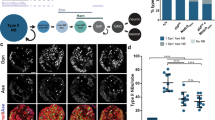Abstract
Regularly spaced repeated morphological structures are a common developmental theme among higher eukaryotes. In Drosophila, this is evident in the repeated segments of the larval and the adult cuticle. It has been demonstrated through cell transplantation1 and more recently through molecular techniques2 that these repeated segmental units are established as early as nuclear cycle 14 in the blastoderm embryo. A number of genes have been shown to express their transcripts2, and in two instances their protein products3,4, in a spatially restricted manner at this early stage. Immunofluorescence probes against the protein product of one such gene, fushi tarazu (ftz), reveal that it is distributed in seven evenly spaced stripes across the cellularized cycle-14 blastoderm embryo3. The mechanisms that determine such spatial patterns of gene expression are of fundamental importance for the development of multicellular organisms, but in no case are they well understood. Here we examine the ftz pattern on blastoderm embryos derived from maternal-haploid 1182 (mh 1182)5,6 and daughterless-abo-like (dal)7 females which possess cell densities and sizes both above and below the wild-type levels. The number, spacing and width of the ftz protein positive bands are not altered in these abnormal embryos relative to the wild-type pattern, suggesting that the mechanism by which distance is measured with respect to the ftz protein is independent of cell size and density.
This is a preview of subscription content, access via your institution
Access options
Subscribe to this journal
Receive 51 print issues and online access
$199.00 per year
only $3.90 per issue
Buy this article
- Purchase on Springer Link
- Instant access to full article PDF
Prices may be subject to local taxes which are calculated during checkout
Similar content being viewed by others
References
1. Simcox, A. A. & Sang, J. H. Devl Biol 97, 212–221 (1983). 2. Scott, M. P. & O'Farrell, P. H. A. Rev. Cell Biol. 2, 49–80 (1986). 3. Carroll, S. B. & Scott, M. P. Cell 43, 47–57 (1985). 4. DiNardo, S., Kurier, J. M., Theis, J. & O'Farrell, P. H. Cell 43, 59–69 (1986). 5. Garis, M., Audit, C. & Masson, M. Genetics 81, 683–704 (1975). 6. Zalokar, M., Audit, C. & Erk, I. Devl Biol 47, 419–432 (1973). 7. Sandier, L. Genetics 86, 567–582 (1977). 8. Foe, V. & Alberts, B. / Cell Sci. 61, 31–70 (1983). 9. Edgar, B. A., Kiehle, C. P. & Schubiger, G. Cell 44, 365–372 (1986). 10. Wang, J. Molec. cell. Biol 5, 3640–3643 (1985). 11. Held, L. I. Willhelm Roux Arch. dev. Biol 187, 105–127 (1979). 12. Santamaria, P. Devl Biol. 96, 285–295 (1983). 13. Cavalier–Smith, T. A. Rev. Biophys. Bioengng 11, 273–302 (1982). 14. Wolpert, L. / theor. Biol. 25, 1–47 (1969). 15. Carroll, S. B. & Scott* M. P. Cell 45, 113–126 (1986). 16. Zalokar, M., Erk, I. & Santamaria, P. Cell 19, 133–141 (1980). 17. Edgar, B. A., Kiehle, C. P. & Schubiger, G. Cell 44, 365–372 (1986). 18. Carroll, S. B., Winslow, G. M., Schupbach, T. & Scott, M. P. Nature 323, 278–280 (1986). 19. Howard, K. & Ingham, P. Cell 44, 949–957 (1986). 20. Gergen, J. P. & Wieschaus, E. F. Devl Biol. 109, 321–335 (1985). 21. Fankhauser, G. in Analysis in Development (eds Willier, B. H., Weiss, P. A. & Hamburger, V.) 126–150 (Hafner, New York, 1955). 22. Fankhauser, G. J. exp. Zoo/. 100, 445–455 (1945). 23. Karr, T. & Alberts, B. M. / Cell Biol. 102, 1494–1509 (1986).
Author information
Authors and Affiliations
Rights and permissions
About this article
Cite this article
Sullivan, W. Independence of fushi tarazu expression with respect to cellular density in Drosophila embryos. Nature 327, 164–167 (1987). https://doi.org/10.1038/327164a0
Received:
Accepted:
Issue Date:
DOI: https://doi.org/10.1038/327164a0
Comments
By submitting a comment you agree to abide by our Terms and Community Guidelines. If you find something abusive or that does not comply with our terms or guidelines please flag it as inappropriate.



